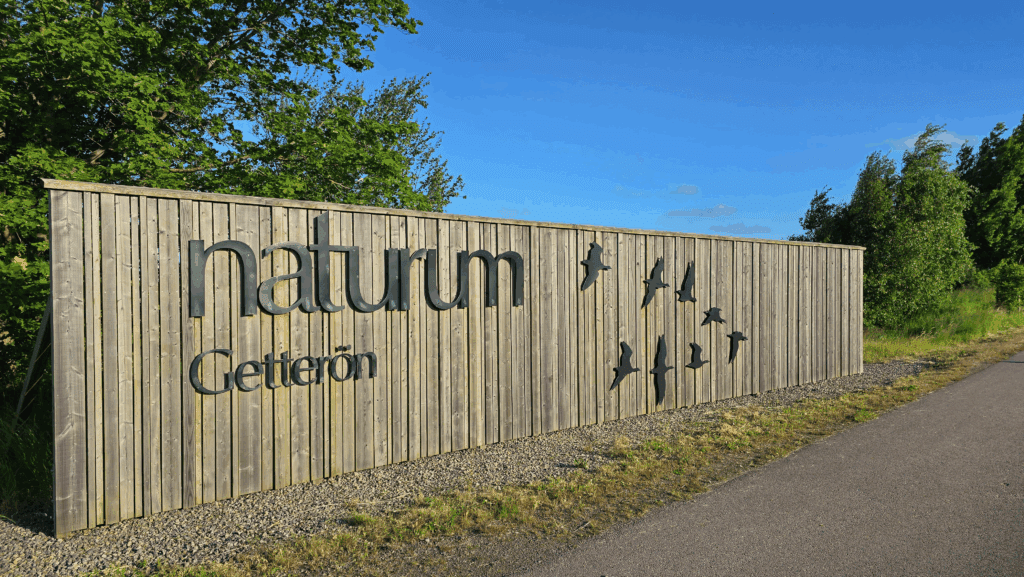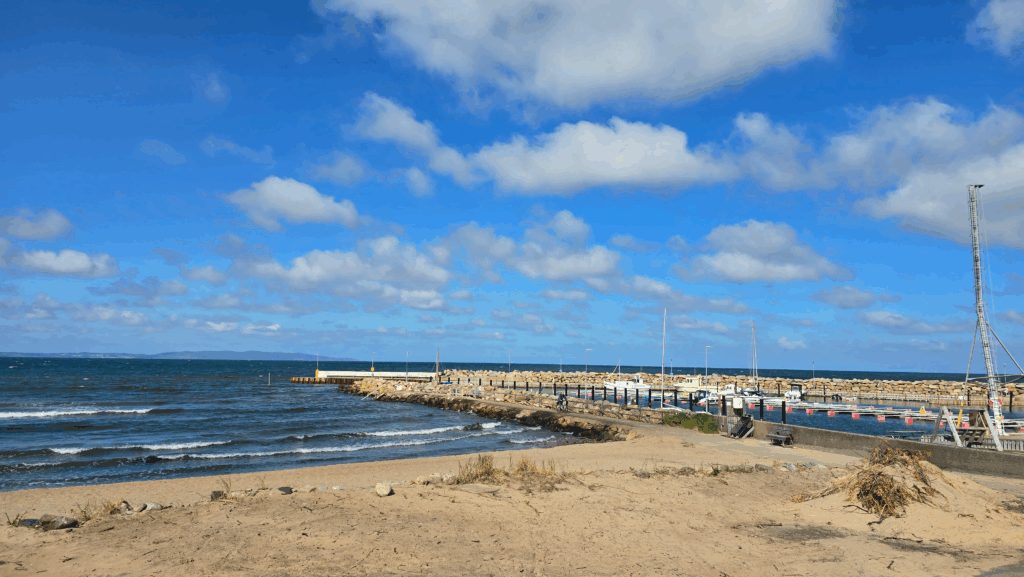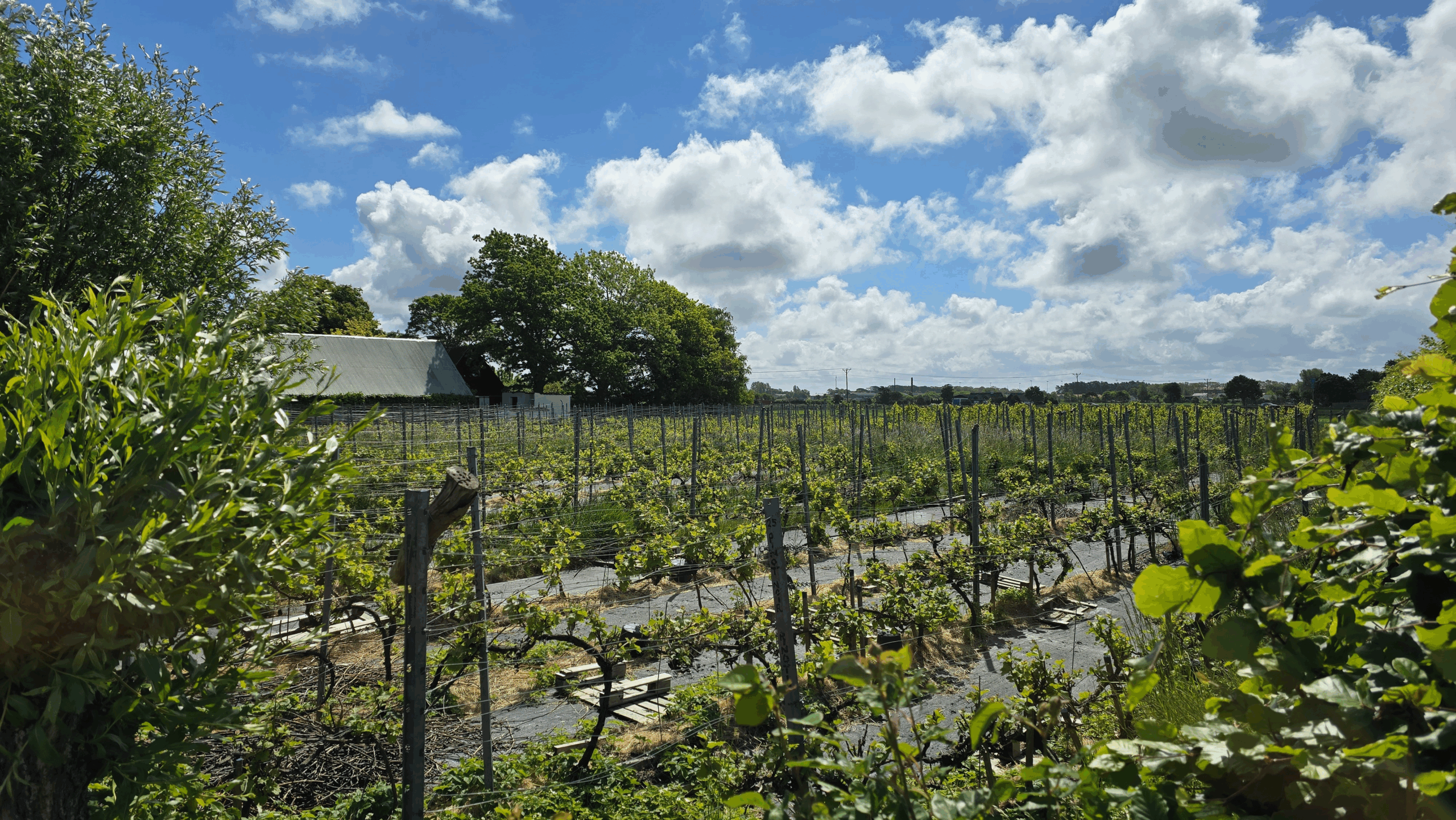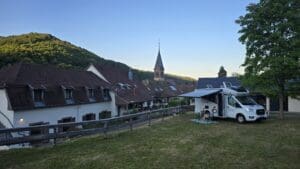As a warm-up for our longer trip to Alsace and Champagne, we thought it would be fun to explore Swedish vineyards. It also happened to be that after twenty years of debate, the farm sale would start on the weekend that suited us. We saw it as fate speaking to us and quickly planned a trip to beautiful Skåne and the Bjäre Peninsula.
As we wanted to make the most of the long weekend, we set off straight after work. However, it is a bit to drive so it was a first overnight stay on scenic Getterön outside Varberg. Here we found a good camping spot right next to Naturum. You can read more about the campsite itself on our other site, button speed.see.

At some point we will return here as we got the impression that there were many nice hiking trails and also a rich bird life. In other words, a good destination for a nature experience.
We travelled a little further and ended up in little Vejbystrand, a tiny village on the Bjäre Peninsula. The plan was to visit two vineyards and a couple of restaurants nearby. Here, too, we found an excellent campsite with an impressive view of the sea and the guest harbour. You can read more about the caravan park here.


First up was Vejby, a biodynamic winery that also uses the more traditional methods developed over 8000 years ago around the Caucasus. This involves, among other things, Qvevri, i.e. storing the wine in clay jugs rather than the more modern wooden barrels and steel tanks. I have to admit that we were somewhat sceptical about the biodynamic part, as in my opinion it contains a lot of hocus-pocus such as burying animal horns in the ground and only planting and harvesting when the planets are aligned. What is extremely positive, however, is that the method also has a strong environmental focus and associated certification.
We had booked a tasting called Partisan, or as they write on the website: "Become a true Vejbyan. No snacks, just wine." I may not feel that that description fits 100% but more on that later.
When we arrived, we first wondered if we had come to the right place, as the door was locked and not a person in sight. However, it turned out to be just a matter of poor city dwellers as the door had been slightly battered in our harsh climate. There were also about twenty bells inside, and when they called in unison for the host's attention, he came running.



The whole farm is a bit like entering another world. Already on the outside it looks more like Provence rather than Sweden and once you enter the courtyard, it's a bit like discovering a secret place that only we know about. Add to this the fact that there is even a wine temple and the sense of unreality is complete. More about the temple later in the post.
Even the small wine bar is personal and special. In the centre of the room is a grand piano where guests can jam out if they feel like it. We saw in their very active media feed that the day before it had been used by a jazz pianist from the United States, so in other words, you can spontaneously get a concert. In addition to the piano, you can safely say that there is a strong wine focus. There are wine-related pins everywhere and on a whiteboard, the overall philosophy behind Vejby vineyard.




Also at the bar is Jeppe Appelin, winemaker and ambassador for Georgian food culture. Having worked as an architect in Denmark, he was puzzled why Swedes didn't grow wine, unlike the Danes who had done so for a long time. When he didn't get a sensible answer, he took matters into his own hands and started growing. It has now been over 20 years since the start and along the way he has made some choices that may not have made life easier. On the one hand, he has chosen to grow blue grapes and on the other hand, he grows biodynamically with all that that entails. As Swedish wine production has matured, other farms have also begun to experiment with Rondo, Regent, Cabernet Cortis, etc. but twenty years ago it was basically only Solaris that was the case.
If you're wondering why you don't recognise these names, it's because they're PIWI grapes. They were developed in Germany to cope with fungal attacks that are common in the cooler parts of the country. However, it has been shown that they are well suited to the Swedish climate, which means that it is basically only PIWI grapes that are grown in Sweden. The alternative would of course have been a lot of chemicals, but since Swedish vineyards were started at a time when agriculture had a different environmental mindset, it was unthinkable for most people. In the long run, this could be a competitive advantage as the EU is now starting to talk about regulating the large amounts of chemicals used in the rest of Europe.
As far as biodynamic farming is concerned, I am a bit torn. The positive part is that they have a holistic approach to nature, which means, among other things, that they do not use chemicals but instead natural substances such as chamomile, stinging nettles, dandelions and a number of different minerals. The negative part, which I perhaps unfairly call hocus pocus, is that they also have an idea about how the cosmos and the positions of the planets affect the process. In practice, this means that you can only prune on root days, water on leaf days, harvest on fruiting days and on flowering days, and then you can leave the plants alone.

Whatever you think of this, Jeppe the charm troll is a storyteller of rank. We had booked the tasting which was described as "an hour of just wine, no talking" and after a three-hour story, you might still think that maybe you should change the description slightly. 🙂 However, it was very interesting and we would have liked to stay three more hours, both because of the completely unique wines that were completely different from anything else we tasted but also because of Jeppe himself.
After tasting about ten different exciting wines, we were really happy in the hat as you might see from the pictures. We also started to get in a hurry as we already missed lunch and now started to get tight to get to the next tasting. But there was one more thing he just had to show us before we left. We lolled after him out into the yard and into a...







... wine temple!?! What we haven't told you yet is that they also make the wine itself according to the method used over 8000 years ago in Georgia. This involves fermenting the wine in large Qvevri, i.e. one and a half tonne clay vessels. It is somewhat unclear in what order these events took place, but the Georgian embassy paid attention to Jeppe, a Georgian priest came to bless the wine, a number of Georgian icons were donated and voila, you had a wine temple. 😉
In addition, there is an annual ceremony where the wine is "re-blessed" and where representatives from both the church and the embassy are present. From what we understand, they also have a choir that sings traditional Georgian songs and there is of course also wine. I imagine that this last part is particularly important for a successful ceremony. This has also made Jeppe a Georgian food ambassador, and he is actively working to spread their distinctive flavour and culture to the rest of the world.


As the Bjäre Peninsula has over 30 wine producers, you are always close to a winery, and the next tasting was just a stone's throw away. The choice fell on Ljungbyholm vineyard, which could not possibly be more different from the one we just left. Here, it's all about modern technology and science rather than leaving it to the whims of nature (and the position of the planets).
It all started when they didn't know what to do with the family farm they had just inherited. Should they make a spa, grow fruit or why not try some grapes?
No sooner said than done, they tried a hundred logs, which was obviously a successful test as they added almost three thousand more the following year. This was six years ago and they are now up to over ten thousand. We also got the impression that they are currently in a scaling phase even when it comes to technology as they have outgrown the equipment they started with. Another thing that was obvious is that they have high ambitions, and in the long run they want to expand much more.



The vineyard tour itself was very traditional and quite basic, but that is understandable as they want to make all visitors interested, whether they are wine enthusiasts or not. However, the big highlight was when you got to taste wines in their cosy greenhouse. It was also not just about the venue itself, but also about the hosts getting more personal. They spoke passionately about all their wines and noble distillates, but also how the whole family helps the farm to reach its full potential. For example, their daughter has painted the motifs for their new wines (see below) and for the Calvados they have used their uncle's apples. They may not call it Grappa or Calvados but they taste very good regardless of the name. 😉
They have three different variants of the tasting, small, medium and large, which mainly differ in how many of the wines you can try. However, it is always possible to buy more glasses if you want to try something else that is not included. In addition to the wine, a charcuterie tray is also included and since we missed lunch, it slipped down in no time. We looked lustfully at the other guests' trays but still thought there would be a fuss if we took a piece of cheese or two from them... 🙂 This with snacks is something that I think should be on all tastings. It's nice, but it's also a question of many wines not really coming into their own until you have something suitable for them. You can also see that they completely change character and personally I find it difficult to fully appreciate a wine unless you have something good to go with it.




After a very nice day we cycled back to Vejbystrand. By now we were so hungry that we could have eaten anything but just as we were about to run away to the best pizza place in town, we spotted a slightly funny sign right where we had parked the car, Korvoteket. It turned out to be a small back pocket to Strandhugget that served artisan sausages, which was exactly what we felt like. Never has a sausage tasted so good. Full and happy, we trudged back to the motorhome for a good night's sleep.



It's amazing how much difference there can be between two different farms. Even though they have the same end goal, the way to get there is completely different. At the same time, that's the charm of humanity, that we have an almost infinite creativity. Anyway, it was an incredible start to our journey and we can really recommend a visit to both these farms.
We already felt that we will probably have to re-evaluate our perception of Swedish wine as it obviously has a huge breadth and also has something for everyone, whether you are a connoisseur or just curious.
We were a little sad to have to leave the fantastic Bjäre Peninsula but it would turn out that the Kull Peninsula was just as exciting. You can read more about this in our next post. On the way there, we passed some quick stops in two cosy cities, Ängelholm and Helsingborg. You can see some pictures from them below.












